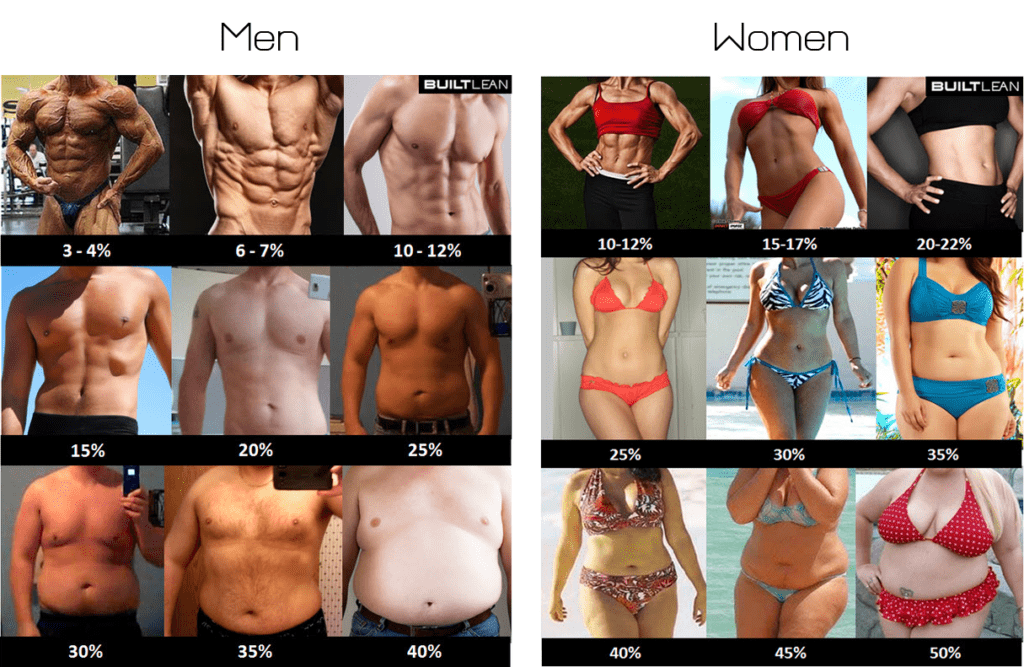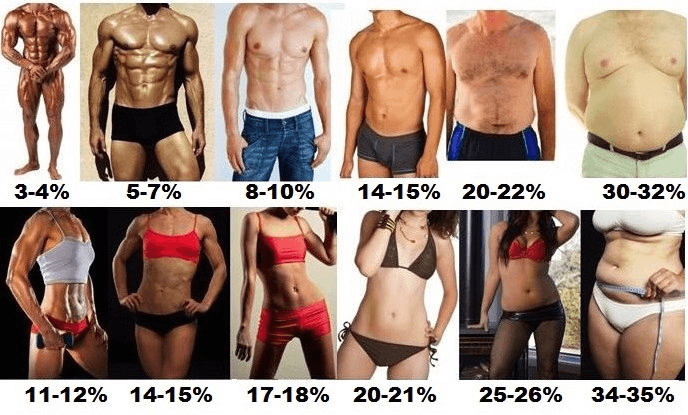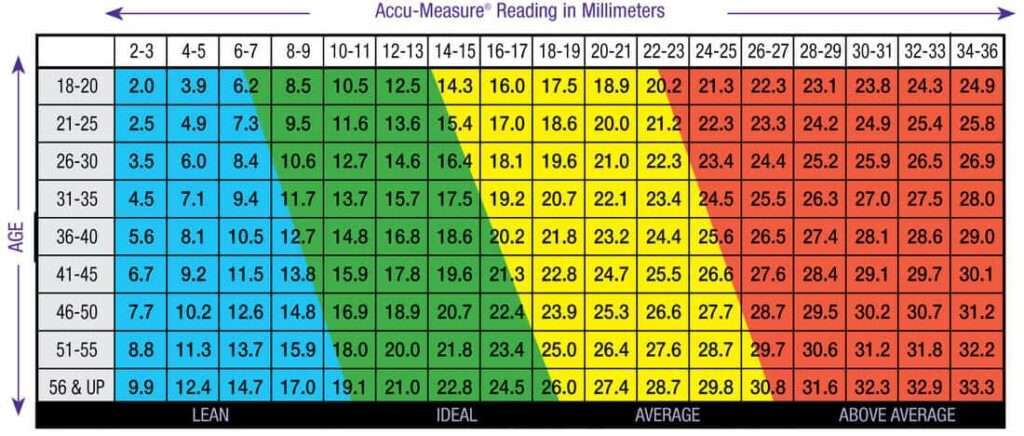? In this article, we’ll explore different methods used to determine your body fat percentage. You’ll learn about popular techniques such as skinfold calipers, bioelectrical impedance analysis, and DEXA scans. We’ll discuss the pros and cons of each method, as well as factors that may affect the accuracy of the results. By the end, you’ll have a better understanding of which method may be most suitable for you to track your body fat percentage.

Methods of Body Fat Measurement
Body Mass Index (BMI)
Many people turn to the Body Mass Index (BMI) as a quick and easy way to determine their body fat percentage. BMI is calculated using a simple formula based on your height and weight. It is widely used in health assessments and provides a general estimation of body fat levels. However, it is important to note that BMI does not directly measure body fat and may not be accurate for certain populations.
Skinfold Calipers
Skinfold calipers are a commonly used tool for measuring body fat percentage. It involves pinching the skin at various locations on the body and using calipers to measure the thickness of the skinfold. This measurement is then used to estimate the amount of subcutaneous fat present. Skinfold measurements can be performed by trained professionals or self-administered. While it is a convenient method, it relies on accurate measurement techniques and may not accurately reflect overall body fat levels.
Bioelectrical Impedance Analysis (BIA)
Bioelectrical Impedance Analysis (BIA) is a method that measures the resistance of electrical currents as they pass through the body. By analyzing the resistance, BIA devices can estimate body fat percentage. BIA can be done using handheld devices or scales equipped with BIA technology. While it is convenient and non-invasive, BIA results can be influenced by factors such as hydration levels and body temperature, which may affect accuracy.
Dual-Energy X-Ray Absorptiometry (DEXA)
Dual-Energy X-Ray Absorptiometry (DEXA) scans are considered one of the most accurate ways to measure body fat percentage. DEXA uses low-dose X-rays to scan the body and differentiate between fat, muscle, and bone. It provides detailed information about body composition and can accurately measure regional fat distribution. However, DEXA scans often require specialized equipment and can be expensive.
Hydrostatic Weighing
Hydrostatic weighing, also known as underwater weighing, involves submerging the body in water and measuring the displacement of water to calculate body density. From body density, body fat percentage can be estimated. This method relies on the principle that fat floats while lean mass sinks. Hydrostatic weighing is considered a highly accurate method but requires specialized equipment and trained professionals.
Air Displacement Plethysmography (ADP)
Air Displacement Plethysmography (ADP), also known as the Bod Pod, measures body composition by assessing the volume of air displaced inside a chamber. ADP calculates body fat percentage based on the assumption that fat-free mass has a known density, allowing for an estimation of fat mass. ADP is known for its accuracy and non-invasiveness but may not be accessible to everyone due to the availability of the technology.
Infrared Interactance
Infrared Interactance is a non-invasive method that uses infrared light to measure body fat percentage. The technology works by analyzing the absorption and reflection of infrared light as it passes through body tissues. Infrared Interactance is relatively quick and easy to administer, but its accuracy can be influenced by factors such as skin color, hydration levels, and the presence of body hair.
Ultrasound
Ultrasound is another non-invasive method used to estimate body fat percentage. It works by sending high-frequency sound waves through the body and measuring the time it takes for the waves to bounce back. The speed of sound is influenced by the different densities of body tissues, allowing for an estimation of body fat percentage. Ultrasound is considered relatively accurate, but its availability may be limited compared to other methods.
MRI
Magnetic Resonance Imaging (MRI) is a medical imaging technique that can also be used to assess body composition and estimate body fat percentage. MRI provides detailed images of fat, muscle, and other tissues by using magnetic fields and radio waves. Although MRI is highly accurate, it is expensive, time-consuming, and typically only used in clinical or research settings.
Comparison of Accuracy and Reliability
When comparing the various methods of body fat measurement, it is important to consider accuracy, reliability, convenience, and cost. DEXA and hydrostatic weighing are often considered the gold standards for accuracy, but they may not be feasible or accessible for everyone. BIA, skinfold calipers, ADP, and ultrasound are generally more accessible and practical options. However, it is important to keep in mind that no measurement method is perfect, and results can vary depending on factors such as hydration levels, measurement technique, and individual differences.
Body Mass Index (BMI)
Calculation of BMI
To calculate your Body Mass Index (BMI), divide your weight in kilograms by the square of your height in meters. The formula is:
BMI = weight (kg) / (height (m))^2
For example, if you weigh 70 kilograms and your height is 1.75 meters, your BMI would be calculated as follows:
BMI = 70 kg / (1.75 m)^2 = 70 kg / 3.0625 m^2 = 22.857
Limitations of BMI as a Body Fat Measure
While BMI is a widely used method for determining body fat levels, it has several limitations. Firstly, it does not directly measure body fat. Instead, it provides a general estimation based on weight and height. This means that individuals with the same BMI may have different body compositions. For example, athletes with high muscle mass may have a higher BMI even though their body fat percentage is low.
Additionally, BMI does not take into account individual variations in body shape and distribution of fat. Some individuals may have a higher amount of visceral fat (fat around the organs) even though their BMI falls within the healthy range. Visceral fat is associated with an increased risk of certain health conditions, such as cardiovascular disease and diabetes.
Suitability for Certain Populations
BMI may not be suitable for certain populations, including athletes, older individuals, and individuals with a high muscle mass. Athletes often have a higher muscle mass, which can increase their BMI without indicating high levels of body fat. Similarly, older individuals may experience age-related muscle loss, resulting in a lower BMI despite having a higher body fat percentage. Other factors, such as ethnicity and bone density, can also affect BMI accuracy.
While BMI provides a useful screening tool for the general population, it should be used in conjunction with other body fat measurement methods for a more accurate assessment of body composition.

Skinfold Calipers
Principle of Skinfold Measurements
Skinfold calipers estimate body fat percentage by measuring the thickness of the skinfold at specific locations on the body. The most common sites for skinfold measurements include the triceps, biceps, subscapular, and suprailiac areas. These measurements are then used to calculate the subcutaneous fat present in the body using prediction equations.
Procedure for Skinfold Testing
To perform skinfold testing, you will need a pair of skinfold calipers and a skilled tester. The measurements are typically taken on the right side of the body. The tester will firmly grasp the skinfold at the designated site and use the calipers to measure the thickness of the fold in millimeters. This process is repeated two to three times at each site to ensure accuracy. The measurements are then entered into prediction equations to estimate body fat percentage.
Accuracy and Limitations of Skinfold Calipers
Skincare calipers can provide a relatively accurate estimation of body fat percentage when performed by a skilled and experienced tester. However, accuracy can vary depending on factors such as measurement technique, caliper type, and tester experience. Additionally, skinfold measurements may not accurately reflect overall body fat levels and may underestimate body fat in certain populations, such as individuals with a high amount of visceral fat.
It is also important to note that skinfold calipers are considered an invasive method, as they involve pinching the skin. Some individuals may find this uncomfortable or embarrassing. Inaccurate measurement techniques, including improper skinfold grasping or inconsistent measurement sites, can also affect the reliability of the results.
Bioelectrical Impedance Analysis (BIA)
Principle of BIA
Bioelectrical Impedance Analysis (BIA) works on the principle that electrical currents pass more easily through lean tissue, such as muscles and body fluids, compared to fat. BIA devices send a low-level electrical current through the body and measure the resistance encountered. The resistance is then used to estimate body fat percentage.
Procedure for BIA
BIA can be performed using handheld devices or scales equipped with BIA technology. The user typically stands on the device’s electrodes while sensors in the device measure the electrical signal as it passes through the body. BIA devices may also require additional information, such as age, gender, height, and weight, to provide accurate results.
Factors Affecting BIA Accuracy
BIA results can be influenced by several factors, including hydration levels, body temperature, and the presence of certain medical conditions. Proper hydration is important for accurate BIA measurements, as dehydration can lead to overestimation of body fat. Consuming excessive amounts of fluids before a BIA measurement may also affect accuracy.
Other factors, such as the presence of metal implants, body position during measurement, and the use of certain medications, can also affect BIA results. It is important to follow the manufacturer’s instructions and recommendations when using BIA devices to ensure accurate measurements.
Advantages and Disadvantages of BIA
BIA offers several advantages as a method of body fat measurement. It is generally non-invasive, quick, and easy to administer. BIA devices are also relatively affordable and accessible, with handheld devices available for home use. However, BIA may not be as accurate as some other methods, such as DEXA or hydrostatic weighing. Variations in hydration levels and other factors can affect the accuracy of BIA results. For the general population, BIA provides a convenient and practical way to monitor changes in body composition over time.

Dual-Energy X-Ray Absorptiometry (DEXA)
Principle of DEXA
Dual-Energy X-Ray Absorptiometry (DEXA) is an imaging technique that uses low-dose X-rays to scan the body and differentiate between fat, muscle, and bone. DEXA can accurately measure body composition by providing detailed information about the amount and distribution of fat and lean tissue. The principle behind DEXA is the differential absorption of X-rays by different body tissues, allowing for precise measurements of body fat percentage.
Procedure for DEXA scan
During a DEXA scan, the individual lies on a table while a scanning arm passes over the body, emitting low-dose X-rays. The machine measures the amount of X-rays that pass through the body, with the densest tissues, such as bone, absorbing more X-rays than less dense tissues like fat. The information is then processed by computer software to generate a detailed body composition analysis.
Benefits and Limitations of DEXA
DEXA scans are considered one of the most accurate methods of measuring body fat percentage. They provide detailed information about body composition, including fat mass, lean mass, and bone mineral density. DEXA scans can also identify regional fat distribution, which can be useful for assessing the risk of certain health conditions.
However, DEXA scans are not without limitations. They require specialized equipment and trained personnel to perform the scans, making them less accessible compared to other methods. DEXA scans can also be expensive and involve exposure to low-dose X-rays, which may not be suitable for pregnant individuals or individuals with certain medical conditions. DEXA scans are typically used in research or clinical settings rather than for routine body fat measurement in the general population.
Hydrostatic Weighing
Principle of Hydrostatic Weighing
Hydrostatic weighing, also known as underwater weighing, is based on the principle that lean tissue is denser than water, while fat tissue is less dense. By measuring the displacement of water, the density of the body can be calculated, and from that, body fat percentage can be estimated.
Procedure for Hydrostatic Weighing
During a hydrostatic weighing session, the individual is submerged in a tank of water and asked to exhale and completely submerge themselves. The weight of the water displaced by the body is then measured and used to determine body density. From there, body fat percentage can be estimated using prediction equations.
Accuracy of Hydrostatic Weighing
Hydrostatic weighing is often considered one of the most accurate methods of measuring body fat percentage. It has been used as a reference method to validate other body composition assessment techniques. However, the accuracy of hydrostatic weighing relies on several factors, including the accuracy of the scale used to measure water displacement, the individual’s ability to fully exhale and submerge themselves, and the accuracy of the prediction equations used to estimate body fat percentage.
Suitability and Limitations of Hydrostatic Weighing
Hydrostatic weighing requires specialized equipment, including a water tank and weighing system, as well as trained professionals to administer the test. This makes it less accessible compared to other methods. Hydrostatic weighing is also not recommended for individuals with certain medical conditions or those who are unable to fully exhale and submerge themselves.
Another limitation of hydrostatic weighing is that it only provides an estimation of body fat percentage and does not provide information about the distribution of body fat. Additionally, variations in hydration levels can affect the accuracy of hydrostatic weighing results. Despite these limitations, hydrostatic weighing remains a highly accurate method for assessing body composition.

Air Displacement Plethysmography (ADP)
Principle of ADP
Air Displacement Plethysmography (ADP), commonly known as the Bod Pod, measures body composition by assessing the volume of air displaced inside a chamber. The principle behind ADP is similar to hydrostatic weighing, where body density is used to estimate body fat percentage. ADP calculates body fat percentage based on the assumption that fat-free mass has a known density.
Procedure for ADP
During an ADP session, the individual sits inside a small chamber, while the volume of air displaced by the person is measured. The measurements are used to calculate body volume, which is then used in conjunction with body weight to estimate body density. From there, body fat percentage can be estimated using prediction equations.
Advantages and Disadvantages of ADP
ADP offers several advantages as a method of body fat measurement. It is a non-invasive method that does not require being submerged in water or exposed to radiation. ADP is quick, comfortable, and easily repeatable, making it suitable for routine monitoring of body composition. It is also suitable for a wide range of populations, including children, older adults, and individuals with medical conditions.
However, ADP may not be as widely available as other methods, as it requires specialized equipment. The cost of ADP sessions may also be a limiting factor for some individuals. ADP results can be influenced by factors such as clothing, hair, and jewelry, which may affect the accuracy of the measurements. However, when performed correctly, ADP can provide reasonably accurate estimates of body fat percentage.
Infrared Interactance
Principle of Infrared Interactance
Infrared Interactance is a non-invasive method that uses infrared light to measure body fat percentage. The technology works by analyzing the absorption and reflection of infrared light as it passes through body tissues. The amount of light absorbed or reflected is used to estimate body fat percentage.
Procedure for Infrared Interactance
During an Infrared Interactance session, the individual sits or lies down while a hand-held device emits infrared light onto the skin at specific locations. The device measures the absorption or reflection of the light and uses this information to estimate body fat percentage.
Factors Affecting Accuracy of Infrared Interactance
Infrared Interactance results can be influenced by several factors. Factors such as skin color, hydration levels, and the presence of body hair may affect the accuracy of the measurements. Darker skin absorbs more infrared light, which may impact the accuracy of the results. Hydration levels can also affect the accuracy of Infrared Interactance measurements, as water content in the skin affects the absorption and reflection of infrared light.
Limitations of Infrared Interactance
While Infrared Interactance offers a non-invasive and relatively quick method of measuring body fat percentage, its accuracy may not be as high as some other methods. The technology used may not be as widely available as other methods, and the accuracy of the measurements can be influenced by various factors. However, when consistent measurement techniques and protocols are followed, Infrared Interactance can provide a reasonable estimation of body fat percentage.

Ultrasound
Principle of Ultrasound
Ultrasound is a non-invasive method that uses high-frequency sound waves to estimate body fat percentage. The technology works by sending sound waves through the body and measuring the time it takes for the waves to bounce back. Different tissues, such as fat, muscle, and bone, have different densities, which affects the speed of sound. By analyzing the speed of sound, body fat percentage can be estimated.
Procedure for Ultrasound
During an ultrasound session, a small handheld device called a transducer is placed on the skin at specific locations. The transducer emits sound waves into the body, and the reflected waves are then captured and analyzed by a computer. The speed of sound is measured, allowing for an estimation of body fat percentage.
Accuracy of Ultrasound
Ultrasound is considered relatively accurate in estimating body fat percentage, especially when compared to methods such as skinfold calipers or bioelectrical impedance. However, the accuracy of ultrasound measurements can be influenced by factors such as body temperature, changes in tissue composition, and the skill of the operator. Proper technique and standardized protocols are important to ensure accuracy and consistency of results.
Applicability and Limitations of Ultrasound
Ultrasound can provide a more regional assessment of body fat distribution compared to other methods. It allows for the measurement of specific areas of interest, such as the abdomen or thigh. This can be useful for assessing the risk of certain health conditions, such as visceral fat accumulation. However, the availability of ultrasound for body fat measurement may be limited compared to other methods, and the accuracy of the measurements can be operator-dependent.
Conclusion
Importance of Body Fat Measurement
Measuring body fat percentage is important for understanding overall health and assessing the risk of certain health conditions. Body composition assessment provides valuable information about the distribution of fat and lean mass, allowing for targeted interventions and monitoring of progress.
Choosing the Most Suitable Method
When choosing a method to measure body fat percentage, several factors should be considered, including accuracy, reliability, convenience, and cost. Key considerations include access to specialized equipment, availability of trained professionals, and individual preferences.
For the general population, methods such as skinfold calipers, BIA, or ultrasound may provide practical and reasonably accurate options for routine body fat monitoring. However, individuals with specific needs or those seeking the highest level of accuracy may opt for methods such as DEXA or hydrostatic weighing, despite their limitations and higher costs.
Regular Monitoring for Progress
Regardless of the method chosen, regular monitoring of body fat percentage is essential for individuals who are striving to improve their body composition. It enables tracking of progress over time and helps to determine the effectiveness of dietary and exercise interventions.
Remember that while body fat measurement methods can provide valuable information, they should be used as part of a comprehensive approach to health and fitness. Other factors, such as overall fitness, strength, and mobility, should also be taken into consideration when assessing overall health and wellbeing.
